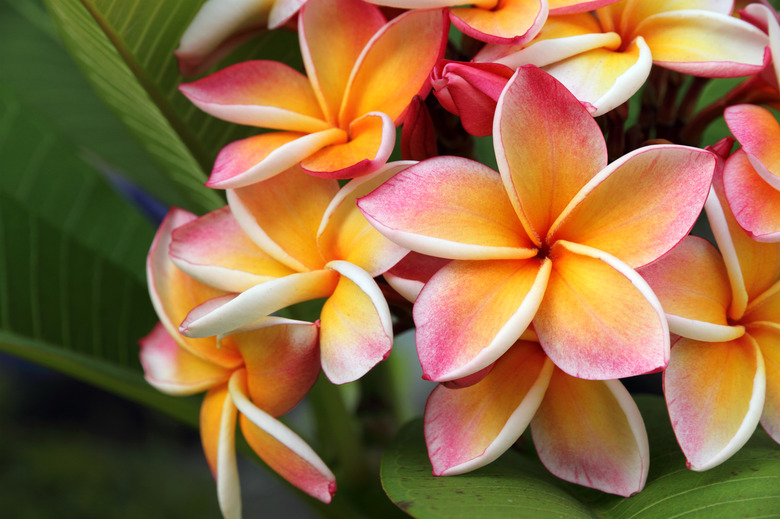How To Grow Plumeria Plants Indoors
We may receive a commission on purchases made from links.
While plumeria plants (Plumeria spp.,) grow best when planted in the ground, you can also grow them indoors in containers if you live in colder climates. These gorgeous flowering trees are hardy in U.S. Department of Agriculture plant hardiness zones 10 to 12 and thrive in full sun. Once the temperature drops below 50 degrees Fahrenheit, plumeria plants stop blooming and lose leaves. Growing a plumeria in a container gives you the flexibility to have a gorgeous houseplant with tropical blooms that you can put outdoors in warmer weather.
Containers for Indoor Plumeria Plants
Containers for Indoor Plumeria Plants
Whether indoors or outdoors, when growing plumeria in a pot, a sturdy construction with ample drainage holes is ideal. Plastic containers are often the lightest and easiest to move if you plan to put your plumeria plants outdoors during the summer months. However, you can use any pot as long as it drains well and has enough room for the roots.
Size is also an important factor and is often dependent on the size of your plumeria. Plenty of space for the roots helps your plumeria plants grow well and thrive. For a general guideline, measure the height of the trunk and choose a pot that's the same number of gallons as the height in feet. A 3-foot plumeria plant should grow well in a 3-gallon pot, for example. Repot your plumeria in the spring when its roots outgrow the pot, moving it up to the next biggest size of pot available.
Choosing Soil and Providing Ample Light
Choosing Soil and Providing Ample Light
Light, porous soil that drains well is ideal when you grow plumeria plants indoors or in any container. Waterlogged soil will kill your plumeria. Cactus soil is often a good choice because it drains well. Whenever you repot your plumeria, use fresh soil to ensure it has the proper nutrients.
Your indoor plumeria plants need lots of sunlight to bloom. Make sure your plumeria gets a minimum of five hours of direct sunlight daily for optimal growth. It can be challenging to find a bright spot indoors, so you can supplement natural light with grow lights. Place this plant where the temperature stays between 65 and 80 degrees Fahrenheit for optimal growth.
Watering Plumeria Plants
Watering Plumeria Plants
Plumeria plants need even, consistent moisture, but overwatering them can quickly kill them. Watch for the leaves to turn yellow as a sign of too much water. The pot size and temperature can affect how often you need to water. Smaller pots and warmer conditions dry out the soil faster, requiring more frequent watering. Let the soil dry slightly between waterings to avoid giving the plant too much moisture.
Humidity is also important for this tropical plant. A cool-mist humidifier can elevate the humidity inside your home to keep your plumeria plant happy. You can also mist the foliage to give it more moisture but avoid misting the blooms.
Plumeria Houseplant Pests
Plumeria Houseplant Pests
Plumeria plants grown indoors are sometimes infested with whiteflies, spider mites and mealybugs. These are common houseplant pests that can often be treated and controlled with insecticidal soap. If you move your plumeria plant outdoors in warmer weather, you can remove many of the pests with a spray of water from your garden hose.
Pruning Indoor Plumeria Plants
Pruning Indoor Plumeria Plants
Pruning your plumeria helps to control the growth to make it fit better inside your home, and it can encourage more vigorous growth and blooming. The ideal time to prune your plumeria is in the late winter or early spring while it's still dormant. Remove up to a third of the branch with sharp pruning shears, cutting each branch at a 45-degree angle above past a node where leaves or branches attach.
Plumeria Winter Care
Plumeria Winter Care
Your plumeria tree goes through a dormant period in the winter. If you put your potted plant outdoors during the summer, bring it indoors when the temperature starts to fall below 55 degrees Fahrenheit. An ideal spot is a cool place, such as a basement. Your plumeria doesn't need much if any water during this dormant period, and it also doesn't need sunlight while it's dormant. Increase water and return your plumeria to a sunny spot once it starts growing again in the spring.
